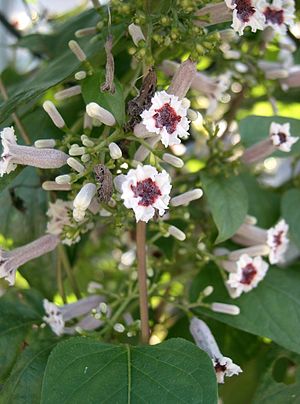Note: This is a project under development. The articles on this wiki are just being initiated and broadly incomplete. You can Help creating new pages.
Paederia foetida - Gandha prasarini
Gandha prasarini is a an important ayurvedic herb. It is a vigorous climber with purple and white flowers. Leaves when crushed emit an unpleasant smell, which is what led to its various vernacular names.
Contents
- 1 Uses
- 2 Parts Used
- 3 Chemical Composition
- 4 Common names
- 5 Properties
- 6 Habit
- 7 Identification
- 8 List of Ayurvedic medicine in which the herb is used
- 9 Where to get the saplings
- 10 Mode of Propagation
- 11 How to plant/cultivate
- 12 Commonly seen growing in areas
- 13 Photo Gallery
- 14 References
- 15 External Links
Uses
Rheumatism, Paralysis, Diarrhea, Dysentery, Infertility, Flatulence, Inflammation.
Parts Used
Chemical Composition
Common names
| Language | Common name |
|---|---|
| Kannada | Gabbu balli, hesarane |
| Hindi | Prasaran, bakuchi, somraj |
| Malayalam | Lepcha, talanili |
| Tamil | cankai-p-pinari, muthiar koonthal, penarisangai, pichulati-elai |
| Telugu | saviraela chettu, gonthe mogaru chettu |
| Marathi | NA |
| Gujarathi | NA |
| Punjabi | NA |
| Kashmiri | NA |
| Sanskrit | Prasarini, gandhapatra |
| English | skunkvine, stinkvine, Chinese fever vine |
Properties
Reference: Dravya - Substance, Rasa - Taste, Guna - Qualities, Veerya - Potency, Vipaka - Post-digesion effect, Karma - Pharmacological activity, Prabhava - Therepeutics.
Dravya
Rasa
Tikta (Bitter)
Guna
Guru (Heavy), Sara(Flowing)
Veerya
Ushna (Hot)
Vipaka
Katu (Pungent)
Karma
Kapha, Vata
Prabhava
Habit
Identification
Leaf
| Kind | Shape | Feature |
|---|---|---|
| Simple | Opposite | Leaves opposite, ovate, nearly glabrous, with a long petiole |
Flower
| Type | Size | Color and composition | Stamen | More information |
|---|---|---|---|---|
| Bisexual | White and purple | Inflorescence of panicled cymes, axillary and terminal. Flowers sessile or pedicelled |
Fruit
| Type | Size | Mass | Appearance | Seeds | More information |
|---|---|---|---|---|---|
| Broadly elliptic | Compressed with 2 dorsally compressed pyrenes | {{{6}}} |
Other features
List of Ayurvedic medicine in which the herb is used
Where to get the saplings
Mode of Propagation
How to plant/cultivate
Cuttings may be planted in raised beds at 10 cm apart row and 5 cm within a row. Double node stem with leaves is recommended for planting in the month of August and September. Seed germination is low, around 25-30%.[4]
Commonly seen growing in areas
Tropical area, Sub tropical area.
Photo Gallery
References
External Links
- Ayurvedic Herbs known to be helpful to treat Rheumatism
- Ayurvedic Herbs known to be helpful to treat Paralysis
- Ayurvedic Herbs known to be helpful to treat Diarrhea
- Ayurvedic Herbs known to be helpful to treat Dysentery
- Ayurvedic Herbs known to be helpful to treat Infertility
- Ayurvedic Herbs known to be helpful to treat Flatulence
- Ayurvedic Herbs known to be helpful to treat Inflammation
- Herbs with Leaves used in medicine
- Herbs with Roots used in medicine
- Herbs with common name in Kannada
- Herbs with common name in Hindi
- Herbs with common name in Malayalam
- Herbs with common name in Tamil
- Herbs with common name in Telugu
- Herbs with common name in Sanskrit
- Herbs with common name in English
- Habit - Climber
- Herbs that are commonly seen in the region of Tropical area
- Herbs that are commonly seen in the region of Sub tropical area
- Herbs
- Bignoniaceae
- Plants of western ghats




